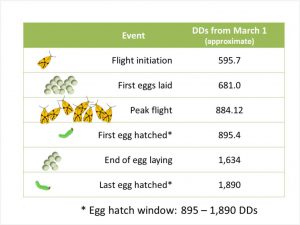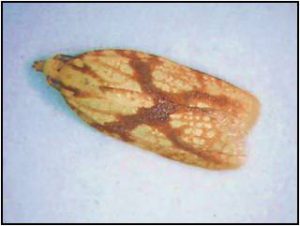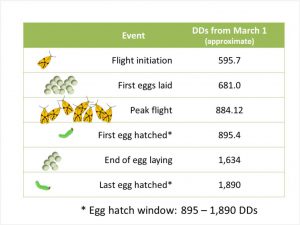Based on our degree-day (DD) model for Sparganothis fruitworm, peak flight is expected at around 884 DD and first eggs hatched expected at 895 DD (see chart). As of June 25, Sparganothis has accumulated 1,118 DD (using March 1 as biofix) or 1,078 DD (using April 1 as biofix). This indicates that we have passed peak flight and eggs have started to hatch. I will keep you updated as the season progresses.
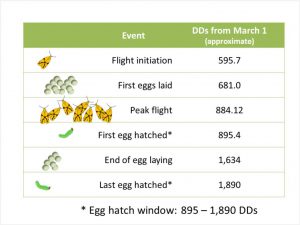
Sparganothis fruitworm degree-day benchmarks
Cranberry beds are in bloom. If insects have been effectively managed prior to bloom, we recommend no sprays at this time. A reminder: when bees are present your only choices of insecticides are insect growth regulators (IGRs) such as Intrepid 2F or Bt products such as DiPel. During bloom we recommend monitoring insect populations using pheromone traps. Pheromone traps should be used particularly to monitor activity of Sparganothis fruitworm and blackheaded fireworm, two key pests in New Jersey.
Sparganothis fruitworm- Damage by the second generation larvae begins after the eggs hatch, usually 9-12 days after they are laid. Based on our DD model, eggs have started to hatch (see above). These larvae will feed on foliage and fruit. Larvae will partially feed on berries, causes scarring of the fruit. However, particularly on Ben Lear, larvae may feed inside the fruit. Insecticide treatment should target small larvae. Pheromone traps can be utilized to time insecticides sprays. If treatment is required, sprays should be applied two weeks after peak moth flight and/or earlier if using an IGR. If trap counts indicate a low population that requires management, a single insecticide application may be made post-bloom. If trap counts are high, then an early application of an IGR may be used when the first eggs start to hatch, i.e., at this time of the year (this is most critical for early varieties). This would be followed by a second application soon after bloom, which is approximately 1,400 DD and will most likely coincide with the 1st-2nd week in July. Your post-bloom options are Diazinon, Altacor, Delegate, or Intrepid.
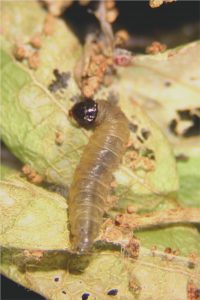
Blackheaded fireworm larva
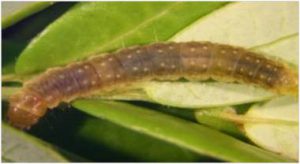
Sparganothis fruitworm larva
As indicated above, controlling fruitworm populations is often very difficult and many require multiple applications depending on pest pressure. Sparganothis fruitworm populations in Massachusetts are resistant to organophosphate insecticides (e.g. Diazinon, Lorsban). Thus, organophosphates should be used with care, i.e., always rotate insecticides with different modes of action. Organophosphate insecticides will also negatively affect natural enemy populations. Delegate, Intrepid and Altacor are reduced-risk insecticides registered against fruitworms and can be used as an alternative to organophosphates post-bloom.
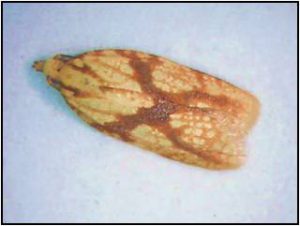
Sparganothis fruitworm adult
